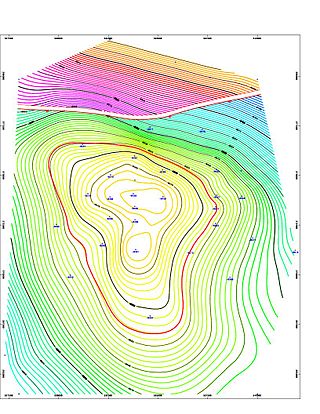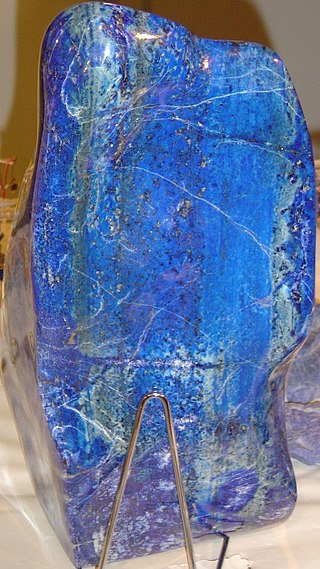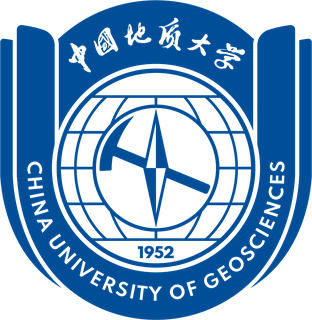
Geologic modelling,geological modelling or geomodelling is the applied science of creating computerized representations of portions of the Earth's crust based on geophysical and geological observations made on and below the Earth surface. A geomodel is the numerical equivalent of a three-dimensional geological map complemented by a description of physical quantities in the domain of interest. Geomodelling is related to the concept of Shared Earth Model; which is a multidisciplinary, interoperable and updatable knowledge base about the subsurface.

Tsumeb is a city of 15,000 inhabitants and the largest town in the Oshikoto region in northern Namibia. Tsumeb is known as the "gateway to the north" of Namibia. It is the closest town to the Etosha National Park. Tsumeb used to be the regional capital of Oshikoto until 2008 when Omuthiya was proclaimed a town and the new capital. The area around Tsumeb forms its own electoral constituency and has a population of 44,113. The town is the site of a deep mine that in its heyday was known as "TCL", but has since been renamed the Ongopolo Mine.

The China Geological Survey (CGS) (Chinese: 中国地质调查局) is a government-owned, not-for-profit, Chinese organization researching China's mineral resources. It is a public institution managed by the State Council's ministries and commissions responsible for geological and mineral exploration under the State Council of the People's Republic of China. According to the national land and resources survey plan, it is now managed by the Ministry of Natural Resources. It is the largest Geoscience agency in China since being reinstated in 1999, and the headquarter is in Beijing, the capital of China.
The Mackay School of Earth Sciences and Engineering is a specialized school within the University of Nevada, Reno. It is named after John Mackay, father of Clarence Mackay.
OMNIS is the Malagasy government organisation, operating under the auspices of the Ministry of Energy, responsible for:

Mining in Afghanistan was controlled by the Ministry of Mines and Petroleum, prior to the August 15th takeover by the Taliban. It is headquartered in Kabul with regional offices in other parts of the country. Afghanistan has over 1,400 mineral fields, containing barite, chromite, coal, copper, gold, iron ore, lead, natural gas, petroleum, precious and semi-precious stones, salt, sulfur, lithium, talc, and zinc, among many other minerals. Gemstones include high-quality emeralds, lapis lazuli, red garnet and ruby. According to a joint study by The Pentagon and the United States Geological Survey, Afghanistan has an estimated US$1 trillion of untapped minerals.
In 2006, Cambodia's mineral resources remained, to a large extent, unexplored. Between 2003 and 2006, however, foreign investors from Australia, China, South Korea, Thailand, and the United States began to express their interest in Cambodia's potential for offshore oil and gas as well as such land-based metallic minerals as bauxite, copper, gold, and iron ore, and such industrial minerals as gemstones and limestone.

Mining is the biggest contributor to Namibia's economy in terms of revenue. It accounts for 25% of the country's income. Its contribution to the gross domestic product is also very important and makes it one of the largest economic sectors of the country. Namibia produces diamonds, uranium, copper, magnesium, zinc, silver, gold, lead, semi-precious stones and industrial minerals. The majority of revenue comes from diamond mining. In 2014, Namibia was the fourth-largest exporter of non-fuel minerals in Africa.

A geologist is a scientist who studies the solid, liquid, and gaseous matter that constitutes Earth and other terrestrial planets, as well as the processes that shape them. Geologists usually study geology, earth science, or geophysics, although backgrounds in physics, chemistry, biology, and other sciences are also useful. Field research is an important component of geology, although many subdisciplines incorporate laboratory and digitalized work. Geologists can be classified in a larger group of scientists, called geoscientists.

Mining in the United Kingdom produces a wide variety of fossil fuels, metals, and industrial minerals due to its complex geology. In 2013, there were over 2,000 active mines, quarries, and offshore drilling sites on the continental land mass of the United Kingdom producing £34bn of minerals and employing 36,000 people.

The Geological Museum of the State Geological Institute is a museum in Warsaw, Poland. The museum was established in 1919.

ZAO Sibplaz is one of Russian leading mining, metallurgical and chemical companies, producing coal, anthracite, coke, nickel, aluminium, zinc, lead, titanium, group of rare metals, and engaging in mineral oil and conducts oil production and gas exploration in Siberia. The company is headquartered in Kemerovo.

Namibia has one of the richest uranium mineral reserves in the world. There are currently two large operating mines in the Erongo Region and various exploration projects planned to advance to production in the next few years.

Dr. Dalaly Peter Kafumu is a Tanzanian CCM politician and Member of Parliament for Igunga constituency since 2011.

Sergo OrdzhonikidzeRussian State University for Geological Prospecting, or the Russian State University for Geological Prospecting is named after Sergo Ordzhonikidze and previously known as the Moscow Geological Prospecting Institute, is a public university based in Moscow, Russia, specialising in geology, geophysics, gemmology, ecology and other earth-science disciplines.

Mining has been practiced in Taiwan for hundreds of years. Sulfur was an early important resource collected on the island. Coal mining expanded in the 19th century to keep up with demand from increased foreign trade. Heavy industry was further expanded under Japanese rule, but air raids towards the end of World War II decimated mining infrastructure, falling below 19th century production levels. Copper mining expanded in the mid-20th century, but ended in the 1980s following a global collapse in the price of copper.

The Ministry of Energy and Mineral Resources of the Republic of Indonesia is an Indonesian ministry responsible for providing assistance to the President and Vice President in performing government's affairs in the field of energy and mineral resources. The current minister is Arifin Tasrif.

The geology of Namibia encompasses rocks of Paleoproterozoic, Mesoproterozoic and Neoproterozoic and Paleozoic to Cenozoic age. About 46% of the countryʼs surface are bedrock exposure, while the remainder is covered by the young overburden sediments of the Kalahari and Namib deserts.

The China University of Geosciences (Beijing) (Chinese: 中国地质大学(北京); abbreviated CUGB or 北京地大) is a public research university located in Haidian District in Beijing. It is a key national university of China and a Double First Class university listed by the Chinese Ministry of Education. The university is under the direct administration of the Ministry of Education and also holds a partnership with the Ministry of Natural Resources of China.
The Geological Survey and Mineral Exploration of Iran or in brief GSI is a government agency responsible for conducting geological and mineral surveys throughout the country, collecting the results of activities carried out in this field, establishing coordination, preparing and publishing geological maps of Iran. It is a subdivision of the Ministry of Industry, Mine and Trade, which was established in 1962 in cooperation with United Nations.
















